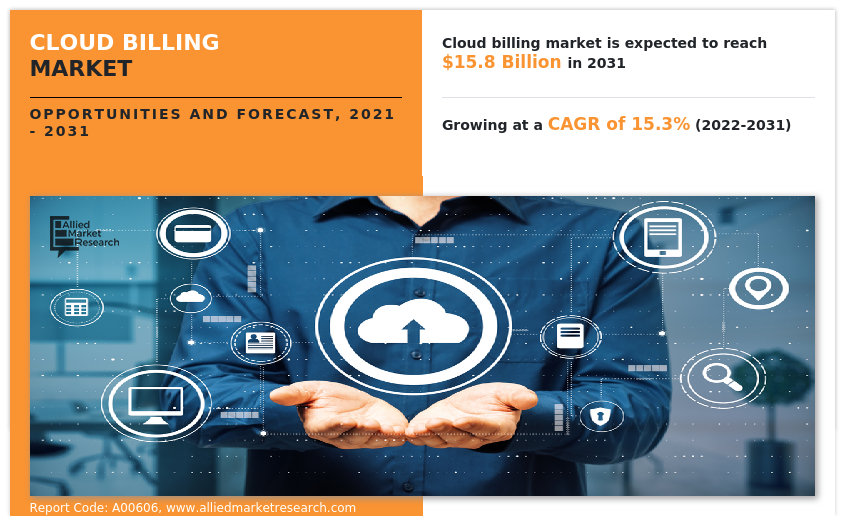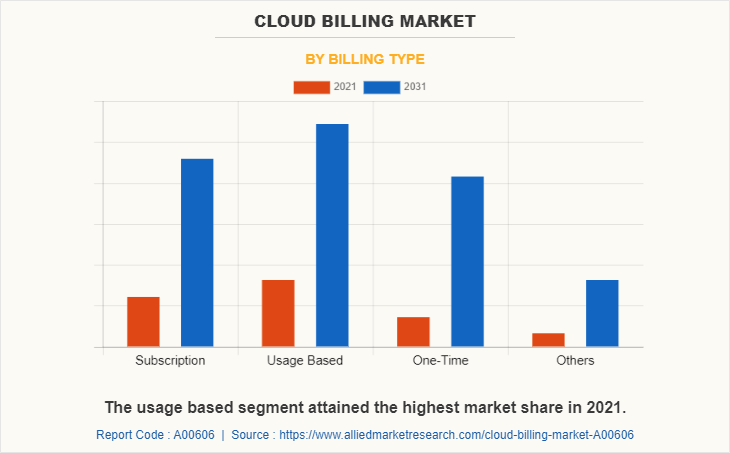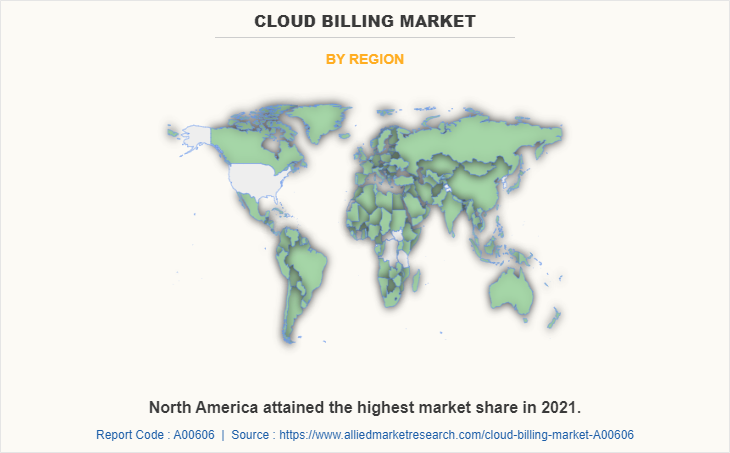Cloud Billing Market Statistics, 2031
The global cloud billing market was valued at $3.9 billion in 2021, and is projected to reach $15.8 billion by 2031, growing at a CAGR of 15.3% from 2022 to 2031.
Adoption of IoT technology in cloud billing in process industries driving the cloud billing market growth. IoT helps in improving efficiency of cloud billing. There has been increasing demand for adoption of IoT system in industries as this system is integrated with cloud billing. In addition, need for lower operational and administration expenditure and need for lower OPEX and CAPEX. Thus, these factors drives the growth of the cloud billing market size. However, increasing cyberattacks and data theft activities and high cost for investment compared with on premises billing hampering the growth of the credit card issuance market size. On the contrary, growing need among enterprises to leverage BI will provide major lucrative opportunities for growth of the cloud billing market forecast.

Cloud billing is a tool that helps in billing for cloud-based infrastructure and software. Cloud solutions can either be deployed on private or public clouds. Cloud billing is described as a technique that assists businesses in generating invoices by enforcing specific standards. Moreover, the cloud permits organizations to streamline their billing process, thus improving the overall customer experience. The deployment of cloud billing solutions reduces IT resources and infrastructure required through the minimal need for integration and expensive hardware.
The report focuses on growth prospects, restraints, and trends of the cloud billing market analysis. The study provides Porter’s five forces analysis to understand the impact of various factors, such as bargaining power of suppliers, competitive intensity of competitors, threat of new entrants, threat of substitutes, and bargaining power of buyers, on the cloud billing market size.
Segment Review
The cloud billing market is segmented on the basis of component, billing type, deployment type, service model, enterprise size and industry vertical. By component, it is segmented into life solution and services. By billing type, it is bifurcated into subscription, usage based, one time and others. By deployment type, it is segmented into private cloud, public cloud and hybrid cloud. By service model, it is segmented into IaaS, PaaS and SaaS. By enterprise size, it is bifurcated into large enterprises and small and medium-sized enterprises. By industry vertical, BFSI, IT and telecommunication, education, construction, media and entertainment, healthcare and others. By region, it is analysed across North America, Europe, Asia-Pacific, and LAMEA.

Based on billing type, the usage-based segment attained the highest growth in 2021. This is attributed to the fact usage-based billing provides a way for customers to gain new customers and grow with them as it provide the opportunity for them to try the product and keep the costs low, if not free, as they gradually adapt and increase the usage of SaaS product. In addition, they rely more and more on the value derived, their willingness to pay increases. In fact, TechCrunch says that SaaS companies leveraging usage-based billing as their pricing models are some of the fastest-growing software businesses.

Based on region, North America attained the highest growth in 2021. This is attributed to the North America government has made cloud governance mandatory for successful cloud migrations and cloud security. This helps the region to have the safest cloud services. Further, the main contribution in the region is due to countries such as the US and Canada, as both countries have the presence of major vendors that helps in enhancing the cloud billing solutions and services in the market.
The report analyzes the profiles of key players operating in the cloud billing market such as Amazon Web Services, Inc. Aria Systems, Inc., Cerillion, Chargify, ConnectWise, LLC, Maxio LLC, Oracle, Recurly, Inc., SAP, and Zuora Inc. These players have adopted various strategies to increase their market penetration and strengthen their position in the cloud billing market share.
Market Landscape and Trends
Virtualized workplaces and simplified operations along with accelerated performance are expected to drive the growth of the global cloud billing market over the forecasted period. Demand for enhanced process, lower capital, and operational expenses, convergence, and centralization are anticipated to favor its growth. Moreover, one of the main driving forces behind the expansion of the global cloud billing industry is the high need for enhanced billing processes. Such services streamline the purchasing process, improve client satisfaction, and make it simple for the operator to comprehend and monitor the data. In addition, companies are continuously attempting to reduce their capital expenditures and operational costs. Because of the current competitive environment and global economic crisis, the adoption of cost-effective strategies for restructuring existing business models has increased. Therefore, these are the major market trends for cloud billing market.
Top Impacting Factors
Adoption of IoT Technology in Cloud Billing in Process Industries
Adoption of IoT Technology is enhancing the performance of cloud billing in process Industries. In recent years, the processing industries such as oil & gas, chemical and others have started exploiting IoT technology. IoT helps in improving efficiency of cloud billing. There has been increasing demand for adoption of IoT system in industries as this system is integrated with cloud billing. Thus, IoT can be applied to improve the performance and efficiency of cloud billing, which in turn, will save maintenance costs and create a more secure work environment, thereby fueling the cloud billing industry. In spite of high adoption rates, only 54% of all the devices deployed in the adopter organizations are IoT technology-enabled.
Moreover, increasing demand for error reduction in their products trade have been driving the need of these billing services in the manufacturing industries for the past five years. In addition, cloud billing services are gaining the popularity in the manufacturing industries because of the data security, reliability and cost effective. Furthermore, these cloud billing services are also being deployed owing to the emphasis to assist the manufacturers as well as the supply chain managers in an industry to keep the track about the goods in the industrial warehouses and the goods sold. These are the major driving factors for the growth of the market.
Need for Lower OPEX and CAPEX
Companies constantly strive to lower their capital expenditure and operating costs. The existing competitive landscape and global economic situation have accelerated the adoption of cost-effective measures for restructuring existing business models. Moreover, emerging cloud technology has been gaining high market traction across the globe with its cost saving and better business agility advantages for all organizational sizes. The cloud is allowing organizations to streamline their billing processes, thereby enhancing the overall customer experience. In addition, the deployment of cloud billing solutions brings fiscal benefits for any business, as it considerably reduces the IT resources and the infrastructure required through the minimal need for integration & expensive hardware, as well as reducing the risk of vendor lock-in for billing functions. These billing solutions result in low capital and operating expenditure as they replace manual processes.
Need for Lower Operational and Administration Expenditure
Cost of the product and quality of service are the key factors in any market to retain the business. The promising feature of cloud billing to reduce operational and administration expenditure is creating new opportunities in various end-user industries. For instance, as per a recent press release by Deloitte, more than 60% of the banks across the globe are projected to adopt cloud services for account updates, deposits and loan processing billing with the help of cloud technology by the end of 2021. Moreover, banking and financial services organizations are switching to the cloud-based services to enhance their operations and customer management. In addition, changing business landscape of the BFSI Sector, financial institutions have been taking active measures for automated Banking services including billing, and have also been focusing on risk management techniques associated with the operations.
Increasing Cyberattacks and Data Theft Activities
Cybersecurity is one of the most important factors for smooth business operations. In recent times, there has been a huge rise in the number of data breaches and cyberattacks-instances of cyberattacks have increased over the years, and most enterprises are unaware of this issue and have unprotected data and poor cybersecurity practices in place, making them vulnerable to data loss. For instance, as per data from Cybint Solutions, a cyberattacks takes place every 30 seconds, and, in the year 2019, 62% of businesses experienced phishing and social engineering attacks. As per a report by Norton, the U.S. is expected to account for half of the data breach activities by 2023.
In addition, cloud billing solutions process crucial customer data, product information, and revenue details of an enterprise. This type of data is very important for every enterprise, and this data being compromised might mean an impact on brand image, market position, and business strategy. Hence, increasing cyberattacks and data thefts are expected to restrict the growth of the cloud billing market.
High Cost for Investment Compared with on Premises Billing
The major challenge for cloud Billing is the high cost for investment. Implementing a complete cloud billing involves a considerable initial investment. This is especially prevalent when comparing with on premises billing. The initial investment associated with switching from a human production line to an automatic production line is very high.
In addition, the licenses of these solutions are priced per user or number of customers, and in many cases, users order fewer licenses than required in order to control their costs. The billing system works best under strong IT infrastructure and stable connections, however, enterprises in developing countries face continuous issues with their connectivity and IT infrastructure. Furthermore, there is a necessity for regular maintenance of the system to ensure high reliability, as these solutions process crucial enterprise data. Hence, the high cost of installation, maintenance, and related activities is expected to act as a challenge for vendors operating in the global cloud billing market.
Growing Need Among Enterprises to Leverage BI
Business intelligence includes the collection, integration, analysis, and presentation of business information using various technologies and different practices. It provides businesses insights about customer behavior and products as well as assists in effective decision making. Moreover, in the current scenario, the impact of BI on online shopping is increasing, whereas brick-and-mortar shops are striving to get in-depth information about their businesses. In addition, due to the IoT system's integration with cloud billing, there has been an increase in demand for its adoption in various businesses. IoT can therefore be used to boost cloud billing's effectiveness and performance, which will cut maintenance costs and foster a safer working environment, ultimately driving the cloud billing market. Therefore, these factors will provide major lucrative opportunities in the growth of the market.
Key Benefits for Stakeholders
- This report provides a quantitative analysis of the market segments, current trends, estimations, and dynamics of the cloud billing market analysis from 2021 to 2031 to identify the prevailing cloud billing market opportunities.
- The market research is offered along with information related to key drivers, restraints, and opportunities.
- Porter's five forces analysis highlights the potency of buyers and suppliers to enable stakeholders make profit-oriented business decisions and strengthen their supplier-buyer network.
- In-depth analysis of the cloud billing market segmentation assists to determine the prevailing market opportunities.
- Major countries in each region are mapped according to their revenue contribution to the global market.
- Market player positioning facilitates benchmarking and provides a clear understanding of the present position of the market players.
- The report includes the analysis of the regional as well as global cloud billing market trends, key players, market segments, application areas, and market growth strategies.
Cloud Billing Market Report Highlights
| Aspects | Details |
| Market Size By 2031 | USD 15.8 billion |
| Growth Rate | CAGR of 15.3% |
| Forecast period | 2021 - 2031 |
| Report Pages | 321 |
| By Deployment Type |
|
| By Service Model |
|
| By Enterprise Size |
|
| By Industry Vertical |
|
| By Component |
|
| By Billing Type |
|
| By Region |
|
| Key Market Players | Chargify LLC., Recurly, Inc., Cerillion, Oracle, Amazon Web Services, Inc., Maxio LLC., Aria Systems, Inc., Zuora, Inc., SAP, ConnectWise, LLC. |
Analyst Review
High demand for improved billing operations is one of the major key factors for the growth of the global cloud billing market. The use of cloud billing solutions has financial benefits for any organization since it significantly decreases the IT resources and infrastructure necessary due to the lack of integration and expensive hardware, as well as the danger of vendor lock-in for billing operations.
Furthermore, market players are adopting collaboration strategies for enhancing their services in the market and improving customer satisfaction. For instance, on August 2020, Zuora, in collaboration with GoCardless (UK), introduced a combined subscription payment service. According to Zuora's Subscription Economy Index, subscription revenue has increased eight times faster than sales revenue during the last eight years.
Some of the key players profiled in the report include Amazon Web Services, Inc. Aria Systems, Inc., Cerillion, Chargify, ConnectWise, LLC, Maxio LLC., Oracle, Recurly, Inc., SAP, and Zuora Inc. and Thales. These players have adopted various strategies to increase their market penetration and strengthen their position in the cloud billing market.
Adoption of IoT technology in cloud billing in process industries driving the cloud billing market growth. IoT helps in improving efficiency of cloud billing.
Based on region, North America attained the highest growth in 2021.
The global cloud billing market was valued at $3,894.73 million in 2021, and is projected to reach $15,806.83 million by 2031, growing at a CAGR of 15.3% from 2022 to 2031.
Amazon Web Services, Inc. Aria Systems, Inc., Cerillion, Chargify, ConnectWise, LLC, Maxio LLC, Oracle, Recurly, Inc., SAP, and Zuora Inc.
Loading Table Of Content...



